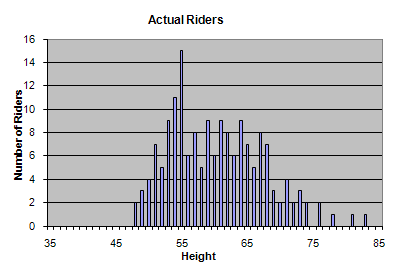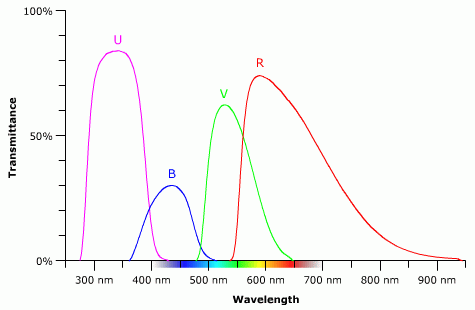Filters
A filter is selective – it allows some things to pass and yet blocks other things. Filters enforce a criteria for passage.


An example of a “filter” from everyday life might be the operator of a roller coaster. The graph above shows the distribution of heights of people who want to ride.

For safety reasons, everyone who gets on the ride must be at least 48 inches tall. Those who are shorter aren't allowed to ride. The graph above shows the “transmittance” function: under 48 inches = no entrance, over 48 inches = entrance.

After the filter is applied, only those who meet the requirement of the filter are allowed to ride. The graph to above shows the distribution of actual riders.
Below is a list of other “filters” that occur in life.
- College Admissions Board
- Sunglasses
- Spam Blocking Software
Most astronomical instruments can only measure the intensity of incident light – they are not able to measure the intensity of light and its wavelength simultaneously. Thus, astronomers make use of filters to control the particular range of wavelengths over which the brightness is measured. A filter is simply a (precisely manufactured) piece of colored glass that is placed in the light beam path between the telescope and the detector. The percentages of each wavelength that are allowed to pass are carefully designed to collect particular pieces of astronomical information.

The passbands for commonly used UBVR filters are shown in the diagram to the right. These are known as broad-band filters since the range of wavelengths that each filter allows to pass is rather large. Astronomers also make use of intermediate-band and narrow-band filters where the range is smaller.
Note that the V filter has maximum transmittance at about 530 nm – its central wavelength. However, it only allows ~63% of the incident light at that wavelength to pass. Broad-band filters are often described in terms of the FWHM (full width at half maximum) which is the wavelength range of the passband at half the maximum transmittance. This is about 90 nm for the V filter. For practice in interpreting this diagram, what are the central wavelength, maximum transmittance, and FWHM of the B filter?
In addition to measuring the brightnesses (apparent magnitudes) of stars through these filters, astronomers are also interested in the difference between filter brightness values. These are known as color indices and their values are often indicative of astronomical values. For example, this lab will explore using the B-V color index as an indicator of stellar surface temperature.